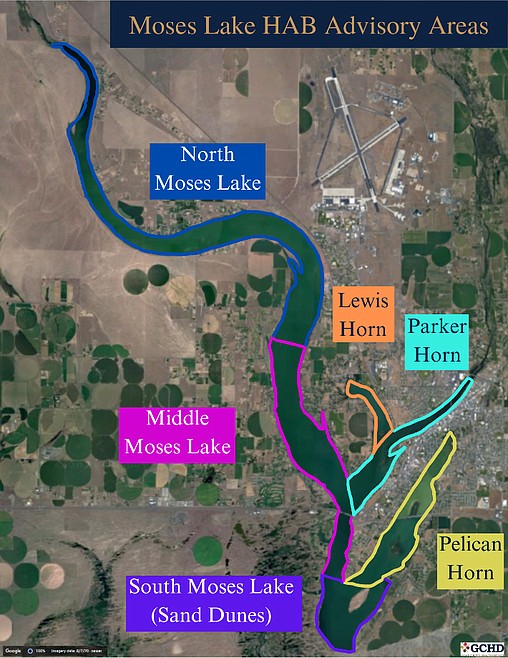Health District outlines new plan for blue-green algae
JOEL MARTIN | Hagadone News Network | UPDATED 2 years, 5 months AGO
Joel Martin has been with the Columbia Basin Herald for more than 25 years in a variety of roles and is the most-tenured employee in the building. Martin is a married father of eight and enjoys spending time with his children and his wife, Christina. He is passionate about the paper’s mission of informing the people of the Columbia Basin because he knows it is important to record the history of the communities the publication serves. | July 13, 2023 5:04 PM
MOSES LAKE — A new system for monitoring blue-green algae in Moses Lake will be rolled out this year, according to a press release from the Grant County Health District.
Moses Lake will now be divided into six sections for monitoring and sampling purposes: North Moses Lake, Lewis Horn, Parker Horn, Middle Moses Lake, Pelican Horn and South Moses Lake, which includes the Sand Dunes, according to the press release. A group of volunteers called the Cyanobacteria Surveillance by Citizens, Users, and Managers (CSCUM) will monitor and sample potential blooms at various points in each section.
One major advantage of this initiative is the ability to issue targeted advisories and warnings for a specific area of the lake rather than an advisory encompassing the entire body of water, the press release said.
“This pilot project has been a goal of GCHD’s for quite some time and we couldn’t have done it without the help of our willing volunteers and community partners, especially the Columbia Basin Conservation District,” GCHD Environmental Health Manager Stephanie Shopbell wrote in the press release. “We are thrilled to see it come to life!”
Volunteers will record and submit their findings using an app, according to the press release. That information will be uploaded to a map that was created in collaboration with the Columbia Basin Conservation District and Moses Lake Watershed Council. Results will then be made accessible to the public, allowing residents and visitors to make informed decisions before committing to a day on the water. Volunteers will make observations at each site weekly throughout the summer and early fall. Results can be found on GCHD’s Blue-Green Algae Monitoring page: https://bit.ly/MLalgae. Anybody who would like to volunteer can also register at the same site.
Blue-green algae blooms grow rapidly in fresh water when there is enough sunlight, high temperatures, and nutrients in the water, the press release said. It often looks like green paint floating on the water. It is common for Grant County waters to have blue-green algae in the summer and fall, but not all blue-green algae blooms are toxic.
Currently, there is a water quality warning advisory for the Perch Point area on Potholes Reservoir. GCHD has also received reports of suspected blue-green algae bloom on Westshore Drive in Moses Lake. No blooms were observed at either Blue Heron Park or Connelly Park by volunteers and no toxin samples were taken.
GCHD recommends residents:
• Avoid areas of scum when boating, swimming or water skiing
• Avoid drinking lake water
• Keep pets and livestock away from these areas
• Clean fish well and discard guts
The type of blue-green algae commonly found in Grant County lakes produce Microcystin toxin, which can cause serious illness in people, pets, and livestock, the press release said. Symptoms may take 30 minutes to 24 hours to appear, depending upon the size of the person or animal affected and the amount of toxic bloom consumed. Microcystin toxicosis may include jaundice, shock, abdominal pain/distention, weakness, nausea/vomiting, severe thirst, rapid/weak pulse and death.
GCHD hopes eventually to expand this pilot project beyond Moses Lake and implement a similar monitoring system on other Grant County lakes known for annual blue-green-algae blooms, according to the press release.
ARTICLES BY JOEL MARTIN

‘Our favorite time of year’
Shop with a Cop brings smiles to both children and officers
MOSES LAKE — The heavy police presence outside local stores recently wasn’t because of a crime wave. It was police officers engaging in their favorite annual event. “This is one of those times throughout the year that we don't have to go and ask for volunteers to help,” said Moses Lake Police Chief David Sands. “The first day we put it out, I think we got 20-some people say ‘Yeah, we’re in.’ That's just under half the department right away.“

BASIN EVENTS: Dec. 19-27
COLUMBIA BASIN — It’s beginning to look a lot like Christmas, and a lot of people will be spending time at home with their families or at the church of their choice. Still, there are a few things happening around the Basin. Here are some ideas:

Chimney maintenance is essential for safety
MOSES LAKE — With Christmas just around the corner, lots of folks are using their fireplaces for warmth, roasting chestnuts or just a pleasant atmosphere. But before Santa pays your chimney a visit, you should make sure it’s in good working order. Chimney fires are responsible for more than three-fourths of residential building heating fires, according to the U.S. Fire Administration. Regular inspections and cleaning are the best way to prevent that, said Michael Harper, known as The Chimney Guy. “If they’re using (the fireplace) aesthetically – date night, Christmas, New Year’s, show-off times, something in the background here and there, (they should) have it inspected once a year for peace of mind,” Harper said. “If they’re using it two to three days a week religiously through the winter months, they need to have it cleaned once a year.”

